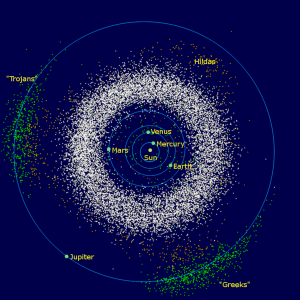Do you remember a very famous quote from Douglas Adams’ The Hitchhiker Guide of the Galaxy about dimensions in space? “Space is big. Really big. You just won’t believe how vastly, hugely, mind-bogglingly big it is. I mean, you may think it’s a long way down the road to the chemist’s, but that’s just peanuts to space.” Well, yesterday I was watching (for the n-time) Star Wars and I have realised that, of many misconceptions Hollywood has reinforced about space, distance and dimensions are among the most relevant ones. Examples?
1. The famous asteroid sequence
I.e., Han Solo and Leia flying into a ring of asteroids, risking collisions every now and then. Do you need a reminder? Watch this:
https://www.youtube.com/watch?v=uTp8mKFxmbg
Now, it seems farfetched to say the least. It simply does not consider distance in space – where what looks like a packed area is nothing of the sort. Let’s take the Solar System. There are many clusters of asteroids, but the main one is the so-called Main Asteroid Belt between Mars and Jupiter. A challenging one to navigate, at least on paper: it comprises a few dwarf planets, such as Ceres – around 1,000 km (620 miles) in diameter – and millions of smaller rocks and debris.

The first spacecraft to transit in the area was NASA’s Pioneer 10 in 1972, and since then a few (unmanned) probes have crossed it safely. If you want to end up on an asteroid, you’d better aim for one, because the density of objects within the belt is so low that the odds of a spacecraft running into one have been estimated at less than one in a billion. Now, even assuming Star Wars features a smaller and more compact area, chances are that would still be wide enough for any Galactic Republic ship to navigate it at ease (for a comparison in size of starships from Star Wars, and others, have a good look here). Han Solo in his tiny starfighter could do it blindfolded and even drunk.
2. Getting to another star system without a hyperdrive whatsoever and without growing old in the meantime.
Taking for granted we can manage a FTL (with all the limitations I have already discussed), many critics have pointed out how is it even possible that the Millennium Falcon gets to fix its FTL….in another star system? No matter how close the two systems might be – like, say, the Sun and Alpha Centauri – it will be still 4.3 LY. Let’s make some calculations here. I will take the above as an example, so that I can avoid any further consideration on the fact that the Universe is expanding (and at a rate of 74.3 plus or minus 2.1 km/second /megaparsec): in the same galaxy, it won’t matter anyway.

A LY is about 9.4605284e12 km. NASA’s Juno spacecraft, the fastest spacecraft to date, can travel up to 40 km/s (when aided by a gravitational slingshot). As Paul Gilster of Tau Zero Foundation pointed out here, “if the goal is to reach Alpha Centauri with a mission lasting, say, forty years, then we need a tenth of lightspeed, or roughly 30,000 kilometers per second.” I will say no more.
Keeping at Star Wars, the (in)famous Death Star is another good case-study, but, since it’s worth a more in-depth analysis and other calculations, I will save it for next time.
Star Wars and Space Problems
Please take a moment to support Amazing Stories with a one-time or recurring donation via Patreon. We rely on donations to keep the site going, and we need your financial support to continue quality coverage of the science fiction, fantasy, and horror genres as well as supply free stories weekly for your reading pleasure.
https://www.patreon.com/amazingstoriesmag










1 Comment